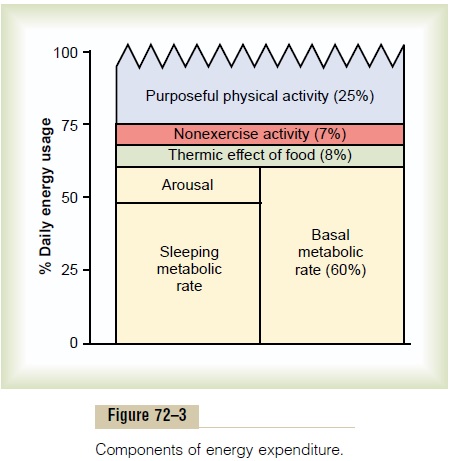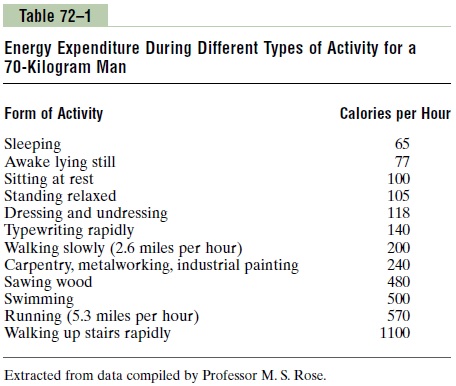Chapter: Medical Physiology: Energetics and Metabolic Rate
Energy Metabolism-Factors That Influence Energy Output
Energy Metabolism-Factors That Influence Energy Output
Energy intake is balanced with energy output in healthy adults who maintain a stable body weight. About 45 per cent of daily energy intake is derived from carbohydrates, 40 per cent from fats, and 15 per cent from proteins in the average American diet. Energy output can also be partitioned into several measurable components, including energy used for (1) performing essential metabolic functions of the body (the “basal” metabolic rate); (2) performing various physical activities; (3) digesting, absorbing, and processing food; and (4) maintaining body temperature.
Overall Energy Requirements for Daily Activities
An average man who weighs 70 kilograms and lies in bed all day uses about 1650 Calories of energy. The process of eating and digesting food increases the amount of energy used each day by an additional 200 or more Calories, so that the same man lying in bed and eating a reasonable diet requires a dietary intake of about 1850 Calories per day. If he sits in a chair all day without exercising, his total energy requirement reaches 2000 to 2250 Calories. Therefore, the approximate daily energy requirement for a very sedentary man perform-ing only essential functions is 2000 Calories.
The amount of energy used to perform daily physical activities is normally about 25 per cent of the total energy expenditure, but it can vary markedly in differ-ent individuals, depending on the type and amount of physical activity. For example, walking up stairs requires about 17 times as much energy as lying in bed asleep. In general, over a 24-hour period, a person performing heavy labor can achieve a maximal rate of energy uti-lization as great as 6000 to 7000 Calories, or as much as 3.5 times the energy used under conditions of no phys-ical activity.
Basal Metabolic Rate (BMR)— The Minimum Energy Expenditure for the Body to Exist
Even when a person is at complete rest, considerable energy is required to perform all the chemical reactions of the body. This minimum level of energy required to exist is called thebasal metabolic rate (BMR) and accounts for about 50 to 70 per cent of the daily energy expenditure in most sedentary individuals (Figure 72–3).

Because the level of physical activity is highly vari-able among different individuals, measurement of the BMR provides a useful means of comparing one person’s metabolic rate with that of another. The usual method for determining BMR is to measure the rate of oxygen utilization over a given period of time under the following conditions:
1. The person must not have eaten food for at least 12 hours.
2. The BMR is determined after a night of restful sleep.
3. No strenuous activity is performed for at least 1 hour before the test.
4. All psychic and physical factors that cause excitement must be eliminated.
5. The temperature of the air must be comfortable and between 68° and 80°F.
6. No physical activity is permitted during the test.
The BMR normally averages about 65 to 70 Calories per hour in an average 70-kilogram man. Although much of the BMR is accounted for by essential activi-ties of the central nervous system, heart, kidneys, and other organs, the variations in BMR among different individuals are related mainly to differences in the amount of skeletal muscle and body size.
Skeletal muscle, even under resting conditions, accounts for 20 to 30 per cent of the BMR. For this reason, BMR is usually corrected for differences in body size by expressing it as Calories per hour per square meter of body surface area, calculated from height and weight. The average values for males and females of different ages are shown in Figure 72–4.

Much of the decline in BMR with increasing age is probably related to loss of muscle mass and replace-ment of muscle with adipose tissue, which has a lower rate of metabolism. Likewise, slightly lower BMRs in women, compared with men, are due partly to their lower percentage of muscle mass and higher percentage of adipose tissue. However, there are other factors that can influence the BMR, as discussed next.
Thyroid Hormone Increases Metabolic Rate. When the thyroidgland secretes maximal amounts of thyroxine, the meta-bolic rate sometimes rises 50 to 100 per cent above normal. Conversely, total loss of thyroid secretion decreases the metabolic rate to 40 to 60 per cent of normal. Thyroxine increases the rates of the chemical reactions of many cells in the body and therefore increases metabolic rate. Adapta-tion of the thyroid gland—with increased secretion in cold climates and decreased secretion in hot climates— contributes to the differences in BMRs among people living in different geographical zones; for example, people living in arctic regions have BMRs 10 to 20 per cent higher than those of persons living in tropical regions.
Male Sex Hormone Increases Metabolic Rate. The male sexhormone testosterone can increase the metabolic rate about 10 to 15 per cent. The female sex hormones may increase the BMR a small amount, but usually not enough to be significant. Much of this effect of the male sex hormone is related to its anabolic effect to increase skeletal muscle mass.
Growth Hormone Increases Metabolic Rate. Growth hormonecan increase the metabolic rate 15 to 20 per cent as a result of direct stimulation of cellular metabolism.
Fever Increases Metabolic Rate. Fever, regardless of itscause, increases the chemical reactions of the body by an average of about 120 per cent for every 10°C rise in temperature.
Sleep Decreases Metabolic Rate. The metabolic ratedecreases 10 to 15 per cent below normal during sleep. This fall is due to two principal factors: (1) decreased tone of the skeletal musculature during sleep and (2) decreased activity of the central nervous system.
Malnutrition Decreases Metabolic Rate. Prolonged malnutri-tion can decrease the metabolic rate 20 to 30 per cent, presumably due to the paucity of food substances in the cells. In the final stages of many disease conditions, the inanition that accompanies the disease causes a marked decrease in metabolic rate, to the extent that the body temperature may fall several degrees shortly before death.
Energy Used for Physical Activities
The factor that most dramatically increases metabolic rate is strenuous exercise. Short bursts of maximal muscle contraction in a single muscle can liberate as much as 100 times its normal resting amount of heat for a few seconds. For the entire body, maximal muscle exercise can increase the overall heat production of the body for a few seconds to about 50 times normal, or to about 20 times normal for more sustained exercise in a well-trained individual.

Table 72–1 shows the energy expenditure during dif-ferent types of physical activity for a 70-kilogram man. Because of the great variation in the amount of physi-cal activity among individuals, this component of energy expenditure is the most important reason for the dif-ferences in caloric intake required to maintain energy balance. However, in industrialized countries where food supplies are plentiful, such as the United States, caloric intake periodically exceeds energy expenditure, and the excess energy is stored mainly as fat. This under-scores the importance of maintaining a proper level of physical activity to prevent excess fat stores and obesity.
Even in sedentary individuals who perform little or no daily exercise or physical work, significant energy is spent on spontaneous physical activity required to maintain muscle tone and body posture and on other nonexercise activities such as “fidgeting.” Together, these nonexercise activities account for about 7 per cent of a person’s daily energy usage.
Energy Used for Processing Food— Thermogenic Effect of Food
After a meal is ingested, the metabolic rate increases as a result of the different chemical reactions associated with digestion, absorption, and storage of food in the body. This is called the thermogenic effect of food, because these processes require energy and generate heat.
After a meal that contains a large quantity of carbo-hydrates or fats, the metabolic rate usually increases about 4 per cent. However, after a high-protein meal, the metabolic rate usually begins rising within an hour, reaching a maximum of about 30 per cent above normal, and this lasts for 3 to 12 hours. This effect of protein on the metabolic rate is called the specific dynamic actionof protein. The thermogenic effect of food accounts forabout 8 per cent of the total daily energy expenditure in many persons.
Energy Used for Nonshivering Thermogenesis—Role of Sympathetic Stimulation
Although physical work and the thermogenic effect of food cause liberation of heat, these mechanisms are not aimed primarily at regulation of body temperature. Shivering provides a regulated means of producing heat by increasing muscle activity in response to cold stress. Another mechanism, nonshivering thermogenesis, can also produce heat inresponse to cold stress. This type of thermogenesis is stimulated by sympathetic nervous system activation, which releases norepinephrine and epinephrine, which in turn increase metabolic activity and heat generation.
In certain types of fat tissue, called brown fat, sym-pathetic nervous stimulation causes liberation of large amounts of heat. This type of fat contains large numbers of mitochondria and many small globules of fat instead of one large fat globule. In these cells, the process of oxidative phosphorylation in the mitochondria is mainly “uncoupled.” That is, when the cells are stimulated by the sympathetic nerves, the mitochondria produce a large amount of heat but almost no ATP, so that almost all the released oxidative energy immediately becomes heat.
A neonate has a considerable number of brown fat cells, and maximal sympathetic stimulation can increase the child’s metabolism more than 100 per cent. The mag-nitude of this type of thermogenesis in an adult human, who has virtually no brown fat, is probably less than 15 per cent, although this might increase significantly after cold adaptation.
Nonshivering thermogenesis may also serve as a buffer against obesity. Recent studies indicate that sympathetic nervous system activity is increased in obese persons who have a persistent excess caloric intake. The mechanism responsible for sympathetic acti-vation in obese persons is uncertain, but it may be medi-ated partly through the effects of increased leptin, which activates pro-opiomelanocortin neurons in the hypo-thalamus. Sympathetic stimulation, by increasing ther-mogenesis, helps to limit excess weight gain.
Related Topics